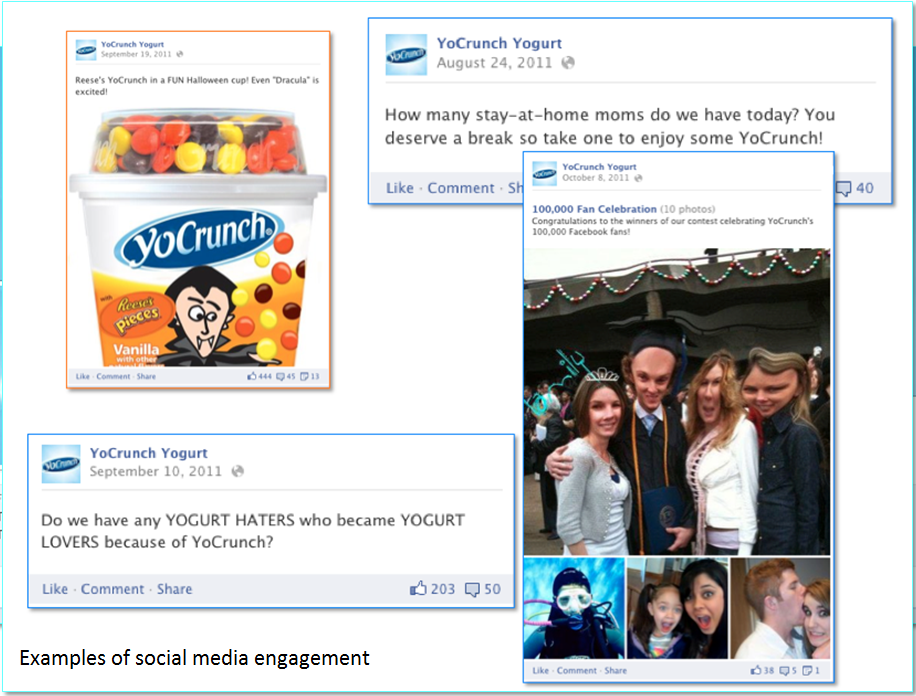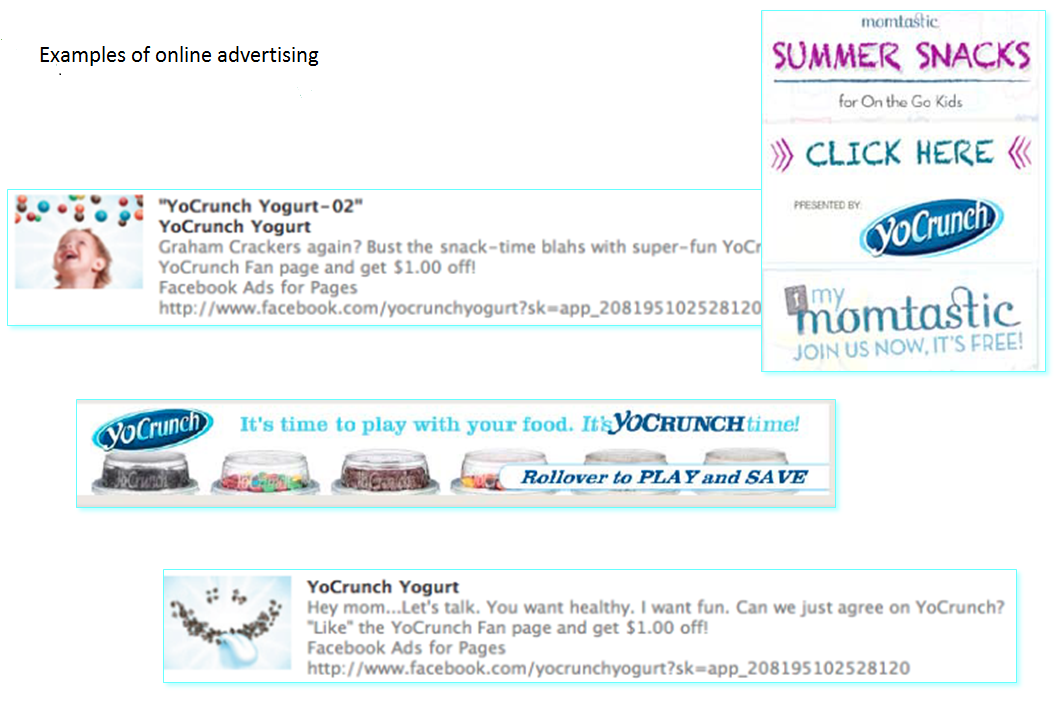Social Media Marketing: YoCrunch boosts average Facebook post interaction 821% (plus two more case studies)
The Social Media Club of Dallas monthly meetings always feature a presentation on social media for attendees, and earlier this year, I had the chance to take in SMC Dallas’ case study “showcase.”
This event offered up a number of quick-hit social media case studies from a variety of marketers and agencies, and I wanted to provide MarketingSherpa blog readers with a sample of several of these presentations.
Local pizza chain increases ROI more than 300% with charitable effort
Background: I Fratelli, a restaurant local pizza chain with nine locations, was preparing for its 25th anniversary. Its brand identity included charitable outreach.
Marketing Opportunity: Understand that local organizations and charities are always in need of fundraising dollars.
Strategy: Create a local social and viral community fundraiser.
Jeff Schick, Director of Integrated Digital Strategy, Online Performance Marketing, said the objective of the effort was to emotionally connect with consumers so they would feel like part of the solution in i Fratelli’s charitable fundraising marketing campaign.
The campaign consisted of five steps:
- Create a name/identity for the effort – in this case, “Pizza DoughNation.”
- Get fans excited by allowing them to nominate their favorite charities.
- Take an “it takes a village” approach, and leverage the networks of fans, charities and organization to spread the word. Seed code words across social media, and have consumers mention these code words during pizza orders.
- Measure the effort by tracking code words.
- Give proceeds to the charities. These check presentations were seeded on owned media, but then drove earned media.
The campaign itself used three main outlets: the website and blog, Twitter and Facebook.
The blog was branded as “The Sauce,” and offered a program overview, nomination form, best practices and tips, and past results for viewing.
Twitter was used for geotargeted and contextual conversations on pizza occasions, and content was regularly pushed out timed for lunch and dinner. Tweets were cross-promoted to both the blog and Facebook. And, influencers were identified to propel the program’s success.
Facebook documented and housed the brand’s “giving back” strategy, and was used to develop relationships with local, regional and national chapters of charities. Also, the Facebook EdgeRank Algorithm was used to focus on an “aggressive news feed optimization strategy.”
Results
- 3,000 unique blog visits for nominations: 86% leads driven by social media, 14% direct URL entry
- Increased Facebook impressions over from 40,000 to 125,000 per month
- Increased retweet rate (generosity) on Twitter from 0 to 19.4%
- Drove ROI in the form of increased sales, ranging from 304% to 381% over first four months of program
- Impacted 32 local charities
Key learnings and takeaways
- Social media results are not just for big brands. SMB brands can leverage social media for attitudinal, behavioral and financial objectives.
- Get the product, service and experience right first.
- Get cross-functional teams involved — that way they begin to place a higher value on social media.
- Don’t be afraid to ask fans and followers for help. Engage with the social media audience.
About the effort, Jeff said, “It wasn’t necessarily a challenge, versus an opportunity. The i Fratelli brand is known for being a part of and giving back to the Dallas-Fort Worth community for the past 25 years. The opportunity was uncovering an idea that leveraged social media to make a greater impact. Historically, the community-giving initiatives were led and funded by i Fratelli alone. By creating the Pizza DoughNation program, fans could take part in and join in on the giving back efforts.”
63% increase in demo leads from video campaign
Jeremy Vest, Senior SEM & Online Manager, Wasp Barcode, explained this online video campaign was an effort to increase both brand awareness and targeted Web traffic.
The campaign was executed in two relatively simple steps:
- Video content was created with the sole intention of reaching a targeted audience. The video was tailored to resonate with individuals looking for a barcoding solution.
- Once the content was completed, Wasp Barcode Technologies implemented an online strategy to ensure their audience saw the content. This included optimizing the content for YouTube search, using YouTube’s social aspect to leverage content engagement, and implementing an ad strategy through Google AdWords for video.
Jeremy said there were several key moments in the campaign:
- Realizing that the videos were engaging people enough for them to come back to the website and become a customer
- Noticing that YouTube was the biggest referrer of quality traffic
- Winning a Stevie American Business Award for the videos
And the video marketing effort produced impressive results:
- Demo leads increased 63%
- Subscribers increased by 4,190
- Website traffic was boosted by more than 450,000 visitors
Jeremy added that the videos also led to higher engagement with the company.
This campaign led to 10 takeaways:
- Social is the most important element to get video views on YouTube.
- YouTube search ranking can be huge for a small business.
- Video can produce great referring traffic if you engage prospects.
- Don’t tell your story — listen to viewers’ needs.
- You only have seconds to engage viewers.
- Inexpensive video advertising works.
- Video content marketing works!
- Search engine keyword research is much different on YouTube.
- Create bad videos and get bad results.
- Viral video is not a marketing plan.
YoCrunch grows Likes from 1,500 to 155,000
YoCrunch faced a business challenge in that it was a small player in the $7.6 billion yogurt and Greek yogurt business category. A space dominated by larger players such as Fage, Chobani and Yoplait.
The question, according to John Lee, CEO, Digital Growth Strategy, was, “How can YoCrunch break through the clutter, and drive awareness, buzz and trial?”
He continued, “The good news is the yogurt category and Greek sub-categories are on fire. The bad news is that there are quite a few large players with deep pockets that can generate almost immediate, widespread awareness. Our challenge was to use our budget very smartly, avoid the big boys and still make a name for YoCrunch.”
To create awareness for YoCrunch, a social media effort was planned with three objectives:
- Grow Facebook fanbase (Facebook was the primary platform, Twitter secondary)
- Drive engagement with fans
- Increase positive brand mentions
John said the overall strategy was to avoid offline advertising and focus all efforts on digital channels. The actual campaign included four elements:
- Create a new interactive website
- Implement an online ad campaign
- Implement the social media strategy including both Facebook and Twitter
- Execute a comprehensive public relations plan
Based on Facebook metrics, here are results for effort between June and December 2011:
- Facebook “Likes” went from 1,500 to 155,000
- Average Facebook post interaction grew from 19 to 175, a lift of 821%
- Positive brand mentions grew from 19% to 32%
And, the campaign produced six key takeaways:
- Integration is essential. No one discipline can stand alone.
- Getting other people to talk about you is effective.
- Select the right social media manager.
- Creating a content strategy and conversation calendar is mandatory.
- Providing user-generated content will appeal to hardcore fans. Others need to be incentivized, although it doesn’t take much. For example, the team offered bloggers coupons they could share with their readers in exchange for actions from the readers, such as posting their favorite flavor to the YoCrunch Facebook wall.
- Understand the best practices for each social media platform.
John added a few comments about what he learned from this effort:
Integration is crucial. Social media is not a zero sum game. All marketing disciplines need to play nice together in order to drive success.
Who companies choose as their voice online is of utmost importance. Especially in the case of a consumer brand, your online voice cannot be an intern or some other low-level employee.
In the case of YoCrunch, Barbara DeBisschop is the best. She has been with the company for years and is passionate about the brand. She also comes from the customer service department, so, even before the appearance of social media, she had an empathetic, customer-centered approach to her work. These skills really show in the content she posts and the way she treats people online.
Content cannot be purely focused on the company’s products. Sure, we are there to sell yogurt eventually, but who is the customer and what do we know about what they are going through on a daily basis?
In the case of YoCrunch, it’s busy moms. They are stressed, tired and trying to do the right thing for their families. How can we help? What sort of tips can we provide to help make their lives easier? It is posts along these lines that tend to perform the best.
Related Resources
Social Media Case Studies – 2012 Showcase – via SMC Dallas
7 Unexpected Ways Online Video Helped Our Small Business – via ReelSEO
How to Increase Views and Exposure in YouTube with Custom Branded Thumbnails – via ReelSEO
Social Media Marketing: Finding and winning hyper-social consumers
Social Media Marketing: 7 steps for using contests and sweepstakes to promote your brand
Marketing Research Chart: Top social media objectives for 2011
Social Media Metrics: Three touchy-feely numbers to help you benchmark and improve
Categories: Social Networking Evangelism Community blog, Facebook, social media marketing, Twitter, video, YouTube












